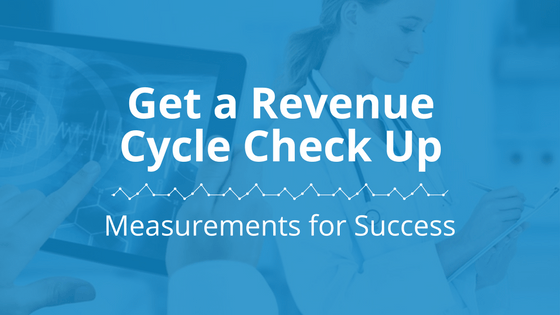
In healthcare, as it is in many industries, cash is king. Of course your financial team will deep dive into financial performance throughout the year, but on a regular basis many hospitals and practices assess the health of their revenue cycle based on cash flow alone. However, accounts receivable is only one metric to monitor. Here are five additional simple key metrics that have been identified by the AAFP to measure regularly to ensure the health of your revenue cycle.
Days in AR
Understanding the average number of days it takes your organization to get paid is critical for making financial decisions. Knowing your Days in AR can provide insight into the efficiency of your revenue cycle and collection procedures from scheduling and registration through post-service and bad debt collection. This metric not only tracks patient payments, but also helps to identify slow-paying commercial payers and measures the performance of your medical collection agency for an overall view of the effectiveness of your revenue cycle processes.
For best results, Days in AR should be below 50 days at minimum, but best performers are more often between 30 and 40 days.
Days in AR Greater than 120 Days
Simply knowing your average Days in AR will not keep some of your accounts from aging beyond 120 days. Calculating how much of your receivables are older than 120 days will indicate your practice’s ability to collect timely payments. Many organizations will keep their past-due accounts in-house through this time frame, so high or rising percentages within this metric may mean there are problems with your practice’s internal patient collection procedures. This metric is becoming increasingly more important as out-of-pocket costs rise, so keep a close eye on it.
Ideally only 12 – 25% of your AR should reach this age, but the lower the better. The cost to collect only increases over time, and the longer you age your receivables the less likely it is you will recover them, or the more it will cost you to do so.
Adjusted Collection Rate
Collection metrics are often skewed by the discrepancy between total charges and the actual allowable amount. This measurement gives a more realistic view of what you have collected versus what you should have, or could have, collected based on the total allowed amount. Reviewing this metric can highlight how much revenue is being lost due to issues within your contractual agreements, untimely filing, and uncollectable bad debt.
Best practices dictate that your adjusted collection rate should be 95% or better, but industry best performers can achieve up to 99%.
Denial Rate
Your denial rate is the percentage of insurance claims that are denied by commercial payers. This metric quantifies the effectiveness of your reimbursement process from your largest source of revenue. A low denial rate indicates that your cash flow is healthy and your revenue cycle processes are efficient and concise. Keeping an eye on this metric could alert you to claim denial problems, processing issues, or even changes within payer organizations that could dramatically affect your revenue flow.
The MGMA has indicated that best performers have an average denial rate of 4% or less, but the industry average is between 5 and 10%.
Average Reimbursement Rate
The final metric your practice should be regularly monitoring is average reimbursement rate. This number represents the average amount you collect out of total claims submitted. Understanding your practices performance can help to determine whether you can realistically collect more from your commercial payers with updates to your reimbursement processes.
Ideally, every claim you submit for payment would be paid at 100% but we know that isn’t the case. The industry average is actually only between 35 and 40%.
For the formulas, examples, and more tips on measuring your healthcare organization’s financial health, download our free guide: 5 Metrics for Measuring Revenue Cycle Success.
Take this article with you! Click here for a printable version.
Written by Ali Bechtel, Digital Marketing Manager for RMP
This information is not intended to be legal advice and may not be used as legal advice. Legal advice must be tailored to the specific circumstances of each case. Every effort has been made to assure this information is up-to-date as of the date of publication. It is not intended to be a full and exhaustive explanation of the law in any area, nor should it be used to replace the advice of your own legal counsel.
Tags: accounts receivable, collections rate, denial rate, healthcare revenue cycle management, key performance indicators, metrics, revenue cycle